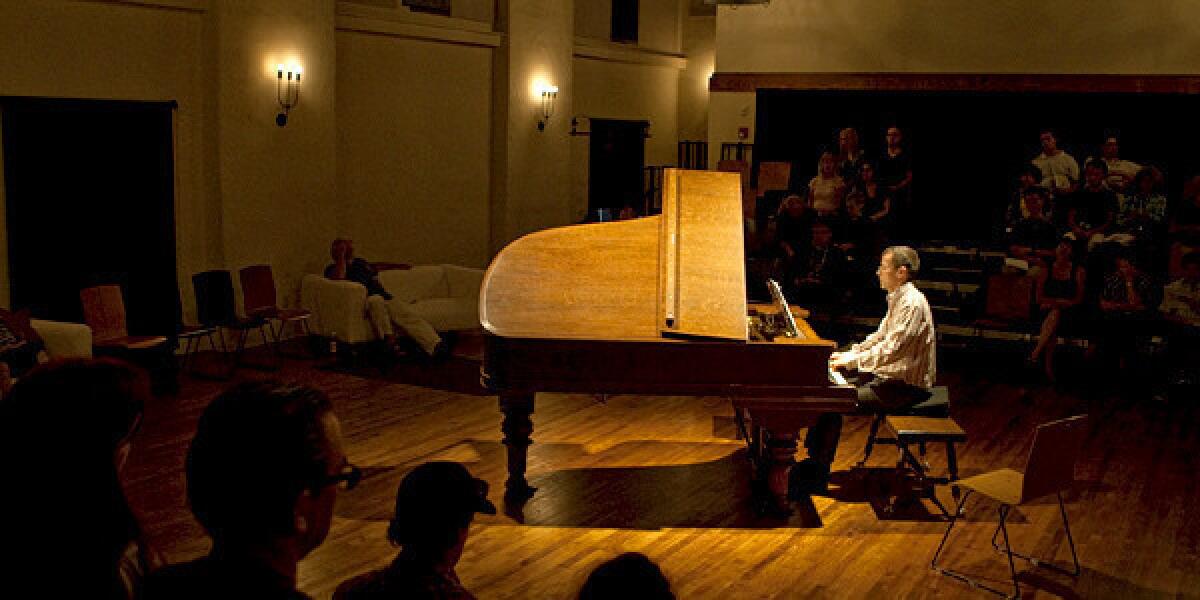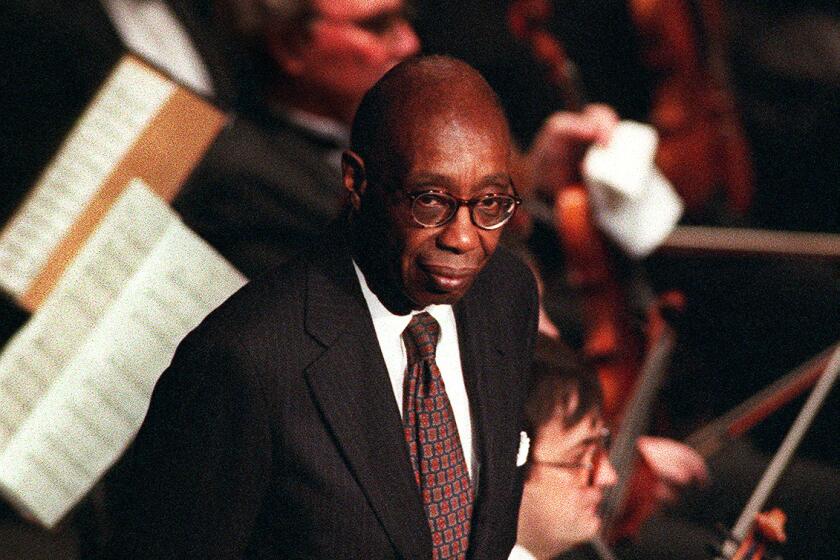Commentary: Why Satie? Why now? How one composer embodies our time of loneliness and angst

- Share via
Safe at home this spring has not necessarily meant sane at home. One antidote is a mega-dose of Erik Satie.
The French composer’s most beguiling and languidly becalming piano pieces, particularly the inescapable “Gymnopédies,” began showing up in April and May on recorded compilations with such titles as “Work From Home: Classical Music for Peace and Calm,” “Working From Home in Peace: Classical Tunes for Concentration,” ”Musique Pour Travailler, Lire, Dormire” (Music for Working, Reading and Sleeping) or just plain “Chill Piano.”
With time on their hands, many a lapsed piano student has begun practicing again, turning to Satie’s simplest scores, which have always been catnip to beginners. In a Zoom dance video, Mark Morris found that a tiny Satie tango proved perfectly suited for tenderly voicing our pandemic solitude. The exquisitely solitary “Lonely Tango” premiered May 29 on YouTube.
Yet two days later, just as America was erupting in mass social protest, pianist Igor Levit, broadcasting from a Berlin studio, gave an incomparable example of keyboard angst by repeating Satie’s “Vexations,” surely the most vexatious single page of music there is, 840 times. He took only the occasional bathroom break, allowing viewers to clock, in real time, the rate of depletion of a heroic pianist’s energy and its effect on the psyche over 15½ hours.
I had merely planned to check out the endurance effort but became fixated and wound up getting many of my daily 10,000 steps by walking back and forth between Levit’s stream on my computer and the television in another room with the live broadcast of demonstrations in Los Angeles over the George Floyd killing. Levit later told the New York Times that he was fully aware of the protest marches in the U.S. as he played. Watching him stay the course in personal expression, each repetition seeming to bring out a different pent-up emotion, summed up a huge range of what felt like our shared feelings.
It might seem an extraordinary thing that a late 19th/early 20th century French composer — and one whose music has had a history of having been dismissed for its seeming simplicity, seeming naiveté and seeming single-mindedness — resonates so effectively in our confused, upside-down world. But, then, in his strange music, his irreverent prose, his inexplicable mannerisms, his radical attitudes and his incomprehensible inconsistencies, Satie may just be what we need: With the insight of a genius and an oddball’s mischievous wit and miraculous wisdom, he turned everything on its head. We have, in fact, all become inhabitants of Satie Land.
Imagine for a minute that Satie was still alive and that we might catch a glimpse of him in his apartment playing one of his pieces on the piano via Zoom. What a sight that would be!
Satie never let a soul into the modest one-room abode in Arcueil, a suburb of Paris, where he had lived for 28 years. After the composer died in 1925, Darius Milhaud helped Satie’s brother, Conrad, clean up the cramped space, and what he discovered has become part of the Satie legend. One upright piano was piled on top of another, the strings on both broken. Strewed everywhere were years’ worth of unopened letters and parcels.
Satie had multiples of the same formal suits, shirts, shirt collars and ties, which were the sum of his wardrobe. He also had identical umbrellas and was never without one. There was a small bed and no place to work. He wrote in cafes.
When Milhaud, who taught at Mills College in Oakland during a big 1960s Satie revival, would describe the astonishing scene, his gentle eyes would become moist. Stepping into this room, Milhaud said he was overwhelmed by its sadness. No one in Satie’s circle — which included the likes of Debussy, Cocteau, Picasso, Man Ray and Duchamp — had any idea that this intriguing, charmingly sociable composer, however eccentric, lived like this.
Milhaud’s message to the typical Bay Area college student, whose record collection invariably included pianist Aldo Ciccolini playing Satie along with the Grateful Dead and Big Brother and the Holding Company, was: Yes, love Satie, but don’t trivialize him.
That has been easier said than done. Satie was seriously neglected for decades, of interest mainly as an object of curiosity, a kooky composer of agreeable treacle. He may have been seen as a visionary by a few, but many more dismissed him as a simpleton. He became the avatar of Muzak and musical meaninglessness. Having embraced Dada, surrealism and mysticism, he was thought a trickster. Much of that is true. Yet none of it was trivial, however much Satie liked to disguise the fact.
Certainly, there is a considerable irony in how this least establishment of composers has become so readily commercialized. Maybe that is just one more instance of Satie’s upside-down-ness. I sit and look out my window while listening to soprano Barbara Hannigan’s profound new recording of Satie’s “Socrate,” a hauntingly serene setting of Plato’s account of the death of Socrates, and what Milhaud described as the unfathomable depth in Satie’s music becomes newly evident. This becomes the experience of witnessing death without the benefit of strong emotion, not out of unfeeling but out of respect for the understanding that life is unknowable without death.
He was the first African American to win a Pulitzer for music, yet he died largely unknown. How the music world is starting to right that wrong.
Satie went through several phases, and they all have a magic for us. He attempted to make music modern by shedding its historical accumulations of techniques and returning to the essential origins of an imagined ancient Greek music, seeking harmonies of the spheres, not our banal sentiments. He took a brief fancy to Gothic religious cults, reinventing medieval chant for his own purposes.
He was a fixture of the naughty fin-de-siècle Montmartre cafes, and wrote infectiously saucy songs and absurdist theater music. There was a period of satire, piano pieces with silly titles and outrageous instructions to the performer. They were short, entertaining and wildly unconventional.
Having become a well-established composer, he returned to school to hone his contrapuntal skills and wrote sassy fugues and supposedly pointless music, which he called “furnishing music,” meant only to be heard in the background. He hopped on all the avant-gardist bandwagons the Paris art world offered. That led to the riotous experimental ballets, notably “Parade,” with a scenario by Cocteau and sets and costumes by Picasso, that incorporated found sounds, including that of a typewriter. He refashioned popular songs and ragtime. One idea didn’t need logical form or narrative to follow the other. Yet Satie kept it all simple and direct.
In this Satie became the first composer for whom making sense was representation of the world as it is, not manipulation of it. He was the first composer of significance who didn’t tell the listener how to think or feel, even when, we learned after the fact, just how much Satie himself did feel.
“Vexations” was the result of the breakup of his only love affair, one with the painter Suzanne Valadon. No one in the composer’s lifetime took seriously the idea that this page with two interconnected short phrases ambiguously harmonized should be repeated 840 times. It wasn’t performed until 1963, when John Cage organized an all-night event with pianists, and it’s heard in occasional marathons in which each pianist tends to find an approach and stick with it. The endurance is for the audience, not the performer.
Levit, however, turned the tables and put the onus on himself. His virtuosity was in meditative invention, as he let his fingers represent the mind as it cycles through its endless states. I have never witnessed its like.
Los Angeles County says they can reopen as soon as Friday, but museums tell The Times they need weeks, maybe months, before they’ll be ready.
Satie’s genius was in his removal of all that was unessential yet leaving in all that felt ambiguous. His musical assemblages became more like disassemblages, with his myriad musical sources so stripped of excess that they sound as if they float in a space outside history. Time slows down.
So many aspects of the pandemic have focused us on what is essential, what we need and what we don’t. We’ve had a chance to look at what we have been too distracted to pay attention to. Surely that has contributed to the social clarity in grasping long-overlooked racial injustice.
Speaking recently on Paul Holdengräber’s the Quarantine Tapes podcast, the irrepressible composer, vocalist and performance artist Meredith Monk mentioned how an artist can have too many ideas. “As a young person,” she said, it was “ideas, ideas, ideas.” But as she matured, she came to understand that what matters most is working with the material itself. “You start honing down to what is essential and really to the bone.”
In this, Satie was the sanest of eccentrics. He could hardly be safe at home, and he had too many ideas. But he became the paradigm of dealing with that.
The Broad Stage in Santa Monica forges ahead with a 2020-21 season that starts outdoors in the fall and moves indoors in January — if it’s safe.
More to Read
The biggest entertainment stories
Get our big stories about Hollywood, film, television, music, arts, culture and more right in your inbox as soon as they publish.
You may occasionally receive promotional content from the Los Angeles Times.













